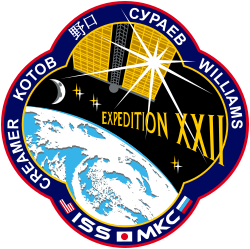 Promotional Poster | |
| Mission type | Long-duration expedition |
|---|---|
| Mission duration | 167 days (at ISS) 169 days (launch to landing) |
| Expedition | |
| Space station | International Space Station |
| Began | 1 December 2009 |
| Ended | 18 March 2010 |
| Arrived aboard | Soyuz TMA-16 Soyuz TMA-17 |
| Departed aboard | Soyuz TMA-16 Soyuz TMA-17 |
| Crew | |
| Crew size | 5 |
| Members | Expedition 21/22: Jeffrey N. Williams Maksim Surayev Expedition 22/23: Oleg Kotov Soichi Noguchi Timothy Creamer |
| EVAs | 1 |
| EVA duration | 5 hours, 44 minutes |
 Expedition 22 mission patch  (l-r) Creamer, Williams, Surayev, Kotov and Noguchi | |
Expedition 22 was the twenty-second long duration crew flight to the International Space Station (ISS). This expedition began on 1 December 2009 when the Expedition 21 crew departed. For a period of three weeks, there were only two crew members; it was the first time that had occurred since STS-114. Commander Jeff Williams and flight engineer Maksim Surayev were joined by the rest of their crew on 22 December 2009, making the Expedition 22 a crew of five. [1]
Contents
The expedition had ended when Soyuz TMA-16 undocked on 18 March 2010, and was immediately followed by the start of Expedition 23.





